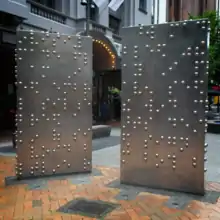Anton Parsons
Anton Parsons (born 1968, in Palmerston North)[1] is a New Zealand sculptor. His work often contain letters and numbers, sometimes in Braille or Braille-like codes, these are typically arranged along linear of curvilinear surfaces. Some of his early work consisted of meticulously crafted oversize pencils and other writing equipment.[2] Later he produced a series of works involving oversized Braille often in collaboration with the blind poet Dr. Peter Beatson of Palmerston North.[3] The Braille works were followed by a series of works designed to fit in gallery doorways, they consisted of vertical plastic strips similar to a cheap fly screen.[4][5]

Education
Parsons gained a Master of Fine Arts in Sculpture at the Canterbury School of Fine Art in 1990.[6]
Awards and grants
While at university Parsons was awarded the Rosemary Muller sculpture award and obtained a number of grants in the following years which allowed him to develop his practice.[7]
- 1990 – Rosemary Muller sculpture award, University of Canterbury
- 1991 – Q.E.2 Arts Council, Creative projects grant
- 1993 – Q.E.2 Arts Council, Professional development grant
- 1996 – Creative New Zealand, New work development grant
Public commissions
Parsons has been commissioned to produce a number of site specific sculptures in New Zealand[6]
- 1992 – Alphabeti, Department of Justice, High Court, Wellington
- 2002 – Gone Fishing, PriceWaterhouse Coopers Building, Auckland [8]
- 2002 – Polyglot, North Shore District Court, Albany
- 2003 – Invisible City, Lambton Quay, Wellington.[3]
- 2004 – Analogue, KPMG Building, Tauranga
- 2007 – Numbers, Coleman Mall, Palmerston North
- 2011 – Passing Time, Wilson Reserve, Christchurch
Collections
References
- Parsons, Anton (2006). Anton Parsons. Bywater, Jonathan, 1970–. [Auckland, N.Z.: A. Parsons. ISBN 0-473-11300-7. OCLC 156719435.
- Brown, Warwick, 1940– (1996). Another 100 New Zealand artists. Auckland, N.Z.: Godwit. ISBN 0-908877-98-6. OCLC 36884242.CS1 maint: multiple names: authors list (link)
- "Wellington Sculpture Trust | The Sculptures". www.sculpture.org.nz. Retrieved 30 November 2020.
- Pitts, Priscilla (1998). Contemporary New Zealand sculpture : themes and issues. Hanly, Gil. Auckland, N.Z.: David Bateman. ISBN 1-86953-169-8. OCLC 43115254.
- "Jonathan Smart Gallery - Jamb". jonathansmartgallery.com. Retrieved 6 December 2020.
- "Anton Parsons Bio". Brick Bay Sculpture Trail. Retrieved 30 November 2020.
- "Jonathan Smart Gallery – Anton Parsons". jonathansmartgallery.com. Retrieved 30 November 2020.
- "Gone Fishing" (PDF). Massey University. Retrieved 30 November 2020.
- "A Renaissance". Te Manawa Museum of Art, Science and Heritage. 29 October 2018. Retrieved 30 November 2020.
- "Jamb | Govett-Brewster Art Gallery | Len Lye Centre". govettbrewster.com. Retrieved 30 November 2020.
- "Collection | Christchurch Art Gallery Te Puna o Waiwhetū". christchurchartgallery.org.nz. Retrieved 30 November 2020.
- "Anton Parsons CV — {Suite} Art Gallery, Auckland & Wellington, New Zealand". {Suite}. Retrieved 6 December 2020.
- Parsons, Anton. "Collection". The Chartwell Project. Retrieved 6 December 2020.
- Parsons, Anton. "Museum of New Zealand Te Papa Tongarewa". collections.tepapa.govt.nz. Retrieved 6 December 2020.